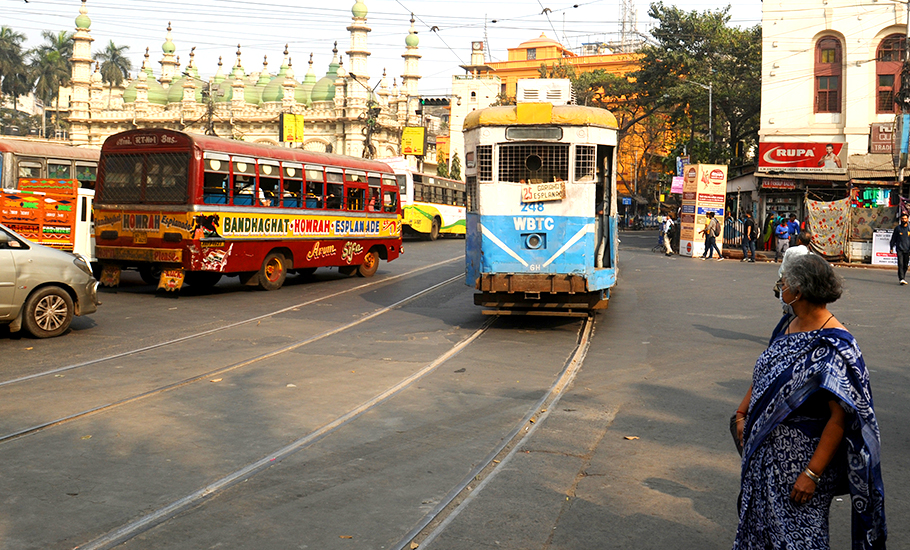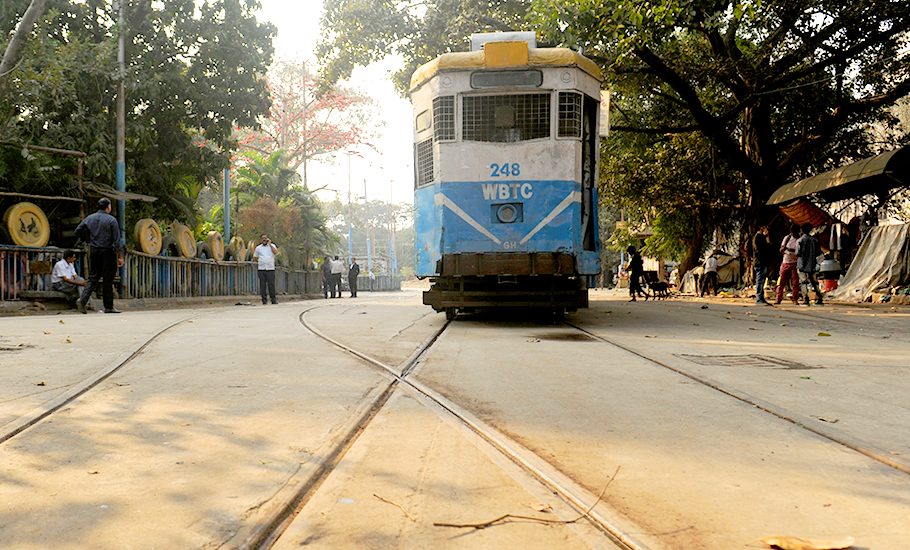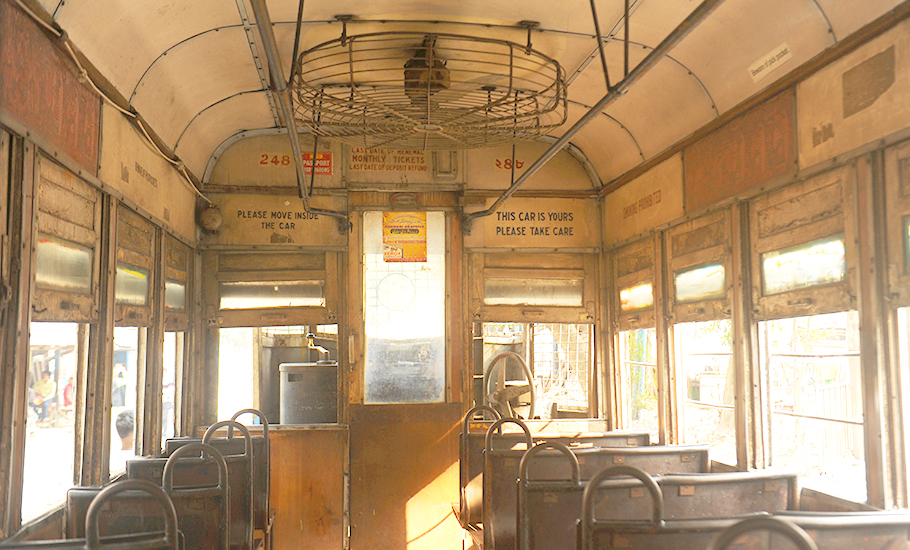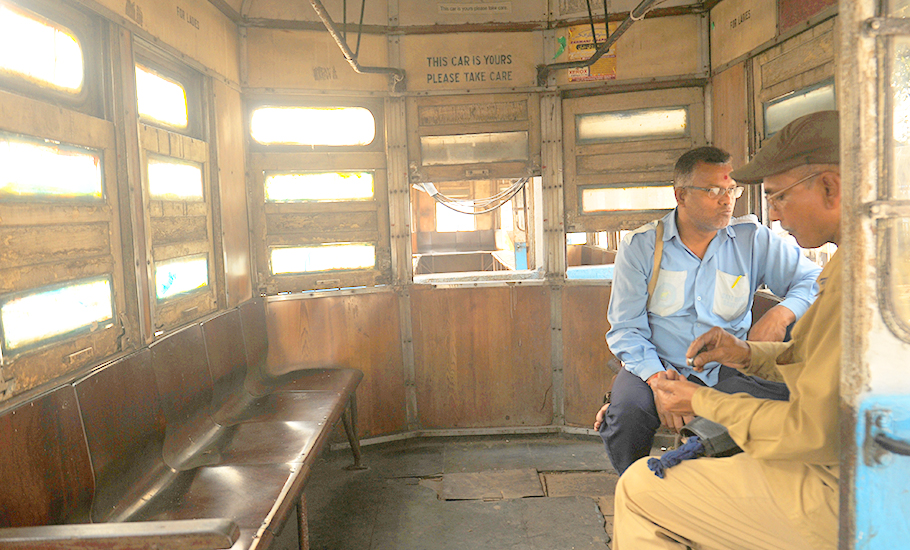
- Home
- News
- Analysis
- States
- Perspective
- Videos
- Education
- Entertainment
- Elections
- World Cup 2023
- Features
- Health
- Business
- Series
- Economy Series
- Earth Day
- Kashmir’s Frozen Turbulence
- India@75
- The legend of Ramjanmabhoomi
- Liberalisation@30
- How to tame a dragon
- Celebrating biodiversity
- Farm Matters
- 50 days of solitude
- Bringing Migrants Home
- Budget 2020
- Jharkhand Votes
- The Federal Investigates
- The Federal Impact
- Vanishing Sand
- Gandhi @ 150
- Andhra Today
- Field report
- Operation Gulmarg
- Pandemic @1 Mn in India
- The Federal Year-End
- The Zero Year
- Premium
- Science
- Brand studio
- Home
- NewsNews
- Analysis
- StatesStates
- PerspectivePerspective
- VideosVideos
- Entertainment
- ElectionsElections
- Sports
- Loading...
Sports - Features
- BusinessBusiness
- Premium
- Loading...
Premium

150 years on, Kolkata’s tram is trundling into oblivion – or not

Supradip Bhattachariya could feel the exhaustion of the day wearing over his body on Wednesday. It was late in the evening around 8 and Bhattachariya, at his home, was somewhere between taking a mental stock of the day drawing to a close and thinking about what all had to be done the next day. And so it took a few moments for Bhattachariya to realise that in his occupied mental space, he...
Supradip Bhattachariya could feel the exhaustion of the day wearing over his body on Wednesday. It was late in the evening around 8 and Bhattachariya, at his home, was somewhere between taking a mental stock of the day drawing to a close and thinking about what all had to be done the next day. And so it took a few moments for Bhattachariya to realise that in his occupied mental space, he had failed to pay attention to a familiar sound moving in his direction. He noticed the sound only when it rose by many decibels.
The familiarity notwithstanding, Bhattachariya found it hard to identify the sound. The sound of a tram trundling in his direction left Bhattachariya pleasantly surprised.
If the pleasure came from a stirred nostalgia, the surprise came because the tonal rumbling created by friction between wheels and tracks of the oncoming tram, which had remained indistinguishable from the noisy city for 15 decades, had begun to sadly fade of late.
The tram service on the Route (No 5) from Shyambazar to Esplanade was suspended about 10 months ago to make way for the metro rail work. Since then, the once ubiquitous noise in the north Kolkata locality had ceased to be a part of the cacophony that otherwise defines Kolkata. What Bhattachariya heard on Wednesday was a tram chugging as part of the trial run of a plan to keep the tram alive on four routes after a decision to discontinue the citywide tram network.

For Bhattachariya, and countless others in Kolkata, there couldn’t have been a better way to mark the 150th anniversary of the tram service in the city today (February 24), which is the oldest operating tram system in the Asia-Pacific region, than welcoming back the tram on selected routes.
Forty-three-year-old Bhattachariya came to know from media reports about the state government’s recent decision to scrap the city’s tram network, barring only four routes — including Route 5 — earmarked as heritage routes.
Given the lack of interest the authorities showed in reviving the tram network in the city, Bhattachariya had come to believe the service, which he had used regularly for a leisurely ride to central Kolkata during his college days, despite the heritage tag, was as good as dead just like almost all networks in the city.
Not that he was too bothered. After all, in his fast-paced city life, the tram had long run out of utility running at an average speed of about 35 km an hour with barely any air conditioners in the hot and humid weather.
More than nostalgia, mobility
But tram in Kolkata is more than just a means of mobility. The 150-year-old tram is part of Kolkatan culture. And that is why, Bhattachariya says, hearing the trundle suddenly on February 22 gave him the same thrill “one experiences on seeing a long-lost college friend”

“Almost in a flash, several sweet memories came rushing back to my mind that I thought had long been erased,” Bhattachariya tells The Federal.
A similar nostalgic-connect, Bengal assembly speaker Biman Banerjee feels with the tram, reportedly prompted the West Bengal transport department to hasten its effort to revive the suspended service on the route.
A trial run was conducted on Wednesday night on the route that passes through Kolkata’s old localities that house some of the city’s iconic landmarks such as the Coffee House, homes of Swami Vivekananda and Iswar Chandra Vidyasagar, College Street and Boi Para, the world’s biggest second-hand book market among others.
Very soon the trams will restart chugging on the road, said sources in the West Bengal Transport Corporation.
The trial runs were initiated a day after Banerjee requested the state transport department not to close the tram services because “many memories” were attached to them.
Incidentally, Banerjee was also a regular passenger on Route 5 during his college and university days, and he is now batting for the continuation of the transport system in the city.
The city’s tram enthusiasts are, however, calling for the revival of trams not merely for the sake of nostalgia. They are against the government’s attempts to turn trams, which were once the mobility lifeline of the city, into memorabilia, running only on four showpiece routes.

“We want the revival of services on all major existing routes. Tracks have been uprooted and filled with bitumen on some routes such as Behala-Joka and the one that passed through Howrah Bridge. The services can be resumed at least on the routes where the tracks are still there,” said Debashis Bhattacharya, president of Calcutta Tram Users Association (CTUA), a non-profit citizens’ pressure group working for the revival of the trams in the city.
The 150-year-long journey
Until the introduction of metro rail service in Kolkata in the 1980s, the tram had an extensive network of 37 routes across the city. Currently, it runs only on two routes — Esplanade-Gariahat and Tollygunge to Ballygunge.
The tram journey in the city started with horse-drawn coaches on a 3.9-kilometre stretch between Sealdah and Armenian Ghat Street on February 24, 1873.
The laying of tracks for electric trams started in 1900. The first electric tramcar on the newly laid tracks ran from Esplanade to Kidderpore on March 27, 1902. On June 14 that year, another electric tram route Esplanade to Kalighat was opened. Gradually, the network expanded virtually to cover every part of the city.
The smooth ride of Kolkata’s tram, however, hit its first hurdle in the 1970s, when the then government started phasing them out on the ground that slow-moving trams were creating traffic snarls.
The Howrah section became the first victim of the growing argument against the tram network with the closure of Bandhaghat and Shibpur lines in 1971.
By that time, trams had fallen out of favour in other Indian cities. Tram services in Mumbai (then Bombay) were closed in March 1964. Prior to that, in 1953, Chennai (then Madras) pulled the plug on the transport system. But the first Indian city to close the transport system was Kanpur in the 1930s.
“Strangely, the reasons cited for the gradual withdrawal of tram services in Kolkata now were the same as those mentioned in the 1950s and 1960s for the termination of services from other Indian cities,” Debashis Bhattacharya said. “These regressive arguments do not hold water today as the trams are making a comeback worldwide because it is the most environment-friendly and inexpensive mode of transportation,” he added.
The argument contradicts the e-vehicle push of the state government, Bhattacharya added.
“You cannot talk about the e-vehicles revolution on the city streets by sounding the death knell for the original e-vehicle,” he argued.
Environmental concerns and ‘conspiracies’
Some environmentalists, however, are not willing to regard trams — at least those run on Kolkata roads — as a very clean means of transportation.
Kolkata-based environmental economist Dr Dipayan Dey said the electricity that propels trams comes from coal-fed thermal power stations.
“In the existing traffic system in the city, it is not feasible to run the tram as it contributes to traffic jams,” further argued Dr Dey, who is also the director of the South Asian Forum for Environment.
Traffic congestion, too, increases air pollution.
Sticking to his contention, Bhattacharya said it is not necessary that electricity is produced from thermal stations, adding that there is a bigger conspiracy behind the move to phase out trams on the pretext of traffic congestion.
“The tram depots located in the prime localities of the city are gold mines for real estate developers. Land of many of these depots has already been sold to real estate developers,” he pointed out.
The erstwhile Calcutta Tramways Company (CTC) had auctioned five plots across the city between 2014 and 2016.
Apart from the real estate angle, there are other factors too that are inducing the early death of trams, according to Bhattachariya.
“Unlike the bus fleet which has a shorter life span, the trams are hardy and do not need any replacement for at least 50 to 60 years, denying the power that be of the opportunity of making money from kickbacks associated with purchase of government vehicles,” he further alleged.
Only a concerted effort by all stakeholders can ensure the revival of the transport system that became integral to the city’s culture and heritage, said the tram enthusiast pointing out how the mode of communication found an important place in many a Bengali movie apart from being a very safe and reliable mode of communications for years.
The ‘multipurpose’ tram
Opening shots of Satyajit Ray’s 1963 Bengali movie Mahanagar (The Metropoly) started with the loop of a moving tram hooked to the overhead electric line. There were many such moments in Bengali movies, particularly of yesteryears, where trams were used as a backdrop to set the tone or to portray the city.
Apart from creativities, Bengalis also vent their anger on trams as the city shared a typical love and hate relation with it.
A tram was set on fire after it hit poet and novelist Jibanananda Das leading to his death in the hospital eight days later on October 22, 1954. The tramcars often became the soft targets during political agitations and stirs in the 1970s and 1980s in the city.
More than those emotions, the rebirth of trams in the city is a necessity to save it from growing air pollution, feel members of the CTUA. They will be organising a week-long programme starting February 24 to mobilise public opinion about the need to revive the city’s tram network for a sustainable mobility solution.

“While modern trams are booming across the west in the battle against ever accelerating global warming, the callousness of Kolkata’s powers that be are actively destroying the first trams in India and a critically needed mode of cleaner public transport,” said another tram enthusiast Anthony Khatchaturian, who is actively involved in the protection of the city’s heritage.

